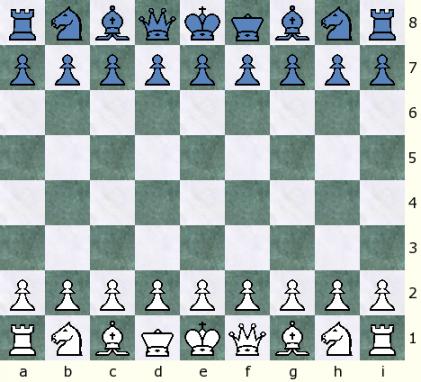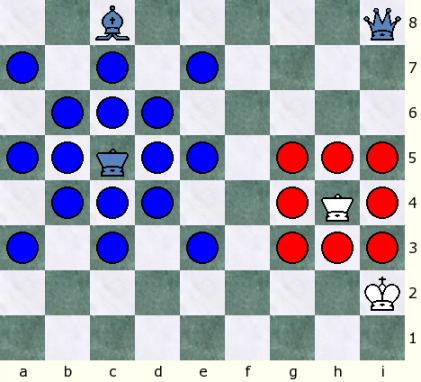Hia Chess
Hia Chess is a 9x8 variation featuring the Mongolian Bodyguard (Hia), introduced in the now extint variation Hiashatar, played about 500 years ago in Mongolia.
You can play 9x8 Hia Chess on a 10x8 board (i.e. Capablanca Chess board) by covering the squares on the 'a' or 'i'-file; or on a 9x9 board (i.e. Modern Chess board or Ministers Chess board) by covering the squares on the 1st or 9th rank.
In the Hia Chess displays above, the Bodyguard (Hia) is represented by the generic Prime Minister piece (from Modern Chess): which is similar to a King without the Cross Crown. But any other fantasy piece can be used to represent the Hia, even a couple of round Checkers pieces.
Setup
 ....
....
Like Hiashatar, Hia Chess has Reverse Symmetry; with the Queen to the right of the King, keeping on with the Shatar tradition.
The Hia (Bodyguard) is then to the left of the King for both armies.
Reverse Symmetry gives both players the same perspective of the board, of their own army as well as their opponent's army. It doesn't matter what color squares a player has to his right, it could be either a light or dark square.
The Hia Chess opening setup is as follows:
White:
King e1; Queen f1; Hia d1; Rooks a1, i1; Knights b1, h1; Bishops c1, g1; Pawns a2, b2, c2, d2, e2, f2, g2, h2, i2.
Black:
King e8; Queen d8; Hia f8; Rooks a8, i8; Knights b8, h8; Bishops c8, g8; Pawns a7, b7, c7, d7, e7, f7, g7, h7, i7, j7.
Pieces
Orthodox Chess pieces are used, plus a Hia (Mongolian Bodyguard) and a 9th Pawn per side. The Mongolian name for the pieces is included below:- King (Noin)
- Queen (Berse)
- Bishop (Teme)
- Knight (Mori)
- Rook (Terge)
- Pawn (Chu)
- Bodyguard (Hia)

The Hia on c5 shows (blue circles) the normal attacking movement of the piece: a 1 or 2 squares slider in any orthogonal or digoanl direction. The Hia cannot leap over the first square (i.e. like an Ajax Minister) to reach his second square. The path must be clear for the Hia to reach his 2nd square. He can capture on either his 1st or 2nd squares.
The Hia on h4 shows (red circles) his 1-square perimeter defending zone of influence, which truncates the path of any enemy slider trying to cross it.
An enemy slider trying to cross a Hia's zone of influence can only reach the very first square in it's path (through the zone of influence), and can only move one-square at a time (in that slider's normal direction) within an enemy zone of influence; but it can slide out of the zone of influece as many squares as possible.
In the example above it would appear that Black's Bishop and Queen are both checking the White King; but this is not the case as the h4-Hia's zone of influence is tuncating the path for both Black pieces.
In the case of the Bishop, he can slide as far as g4, the first square inside of the Hia's zone of influence in the Bishop's path. Within the zone of influence (provided the Hia doesn't capture him) the Bishops only other moves on his next turn would be Bh3+ (check!) and Bh5.
After Bg4, the Bishop would be within striking distance of the Hia, except that the Hia is actually "pinned" by the Queen on i8.
The Black Queen's path itself is truncated at i5 by the Hia's zone of influence. After Bg4, should White try to play Hxg4, the zone of influence (1-square perimeter around the Hia) would move to the left, exposing the White King to check by the Black Queen, which is illegal.
Similarily, should Black play Qi5 (her limit in the Hia's zone of influence), the Hia cannot capture the Black Queen as the zone of influece would move with the Hia exposing the King to a check by the Bishop.
After Qi5, the Queen's only posible moves within the zone of influence (provided the Hia doesn't capture her) would be: Qh5, Qi4 and Qxh4+ (capturing the Hia, destroying the zone of influence, and giving a discovered check with the Bishop).
Because of the inability of crossing through the Hia's zone of influence, it takes sliders (Queens, Bishops, Rooks, opposite Hias and Pawns [on their initial 2-step move]) at least 2 steps to cross or capture a Hia.
Meanwhile, Knights (who are not leapers) are unaffected by a Hia's zone of influence, and can therefore leap and capture the Bodyguards in a single turn.
Hia's are defensive pieces whose goal is the personal protection of their Kings, therefore they should not (even though they are allowed to) wonder too far from their King.
The Hias are unable to check (or checkmate) the enemy King. Therefore a King can aproach (and capture) a Hia without any concerns of an attack from the latter.
Rules
Most Orthodox Chess rules apply, including the objective of the game, the way pieces move and capture, en passant, check, checkmate, and the various draw situations (i.e. stalemate, insufficient mating material, threefold repetition, 50-move rule). Pawns may promote to a Queen, Rook, Hia, Bishop or Knight.Hia Chess has symmetric Short-Castling and the Bishop Adjustment Rule (rules below) from Modern Chess.
The Bishop Adjustment Rules is used to address the issue of both Bishops starting up on the same-color squares. Players are allowed to Adjust one of their Bishops to the opposite color if they wish, but also have the option of playing with both Bishops on the same color squares.
Castling
Castling in Hia Chess is short (O-O) to both flanks of the board. The King jumps 3 squares towards the Rook to castle with.
This table shows where the King and Rook end up and the notation for each type of castling.
| White castles a-side | b-castling | O-Ob | Kb1, Rc1 |
|---|---|---|---|
| White castles i-side | h-castling | O-Oh | Kh1, Rg1 |
| Black castles a-side | b-castling | O-Ob | Kb8, Rc8 |
| Black castles i-side | h-castling | O-Oh | Kh8, Rg8 |
Castling may only occur under the following conditions:
- Unmoved: The King and the castling Rook must not have moved before in the game.
- Un-attacked: All of the squares between the king's initial and final squares (including the initial and final squares) must not be under attack by any opposing piece.
- Vacant: All the squares between the king and the castling rook must be empty.
- Castling cannot capture any pieces.
- The king and castling rook cannot "jump" over any pieces other than each other.
- A player may castle at most once in a game.
- If a player moves his king or both of his initial rooks without castling, he may not castle during the rest of the game.
- The king may not be in check before or after castling.
- The King cannot move through check.
- Castling in Hia Chess is symmetric to either side of the board.
The Bishop Adjustment Rule
Players on their turn, are allowed to convert one (and only one) of their Bishops to the opposite color square by swapping places with any piece adjacent to them. Neither the Bishop nor the piece to be adjusted with may have moved before the Bishop swap. The Bishop adjustment will count as a single turn, and a move for both the Bishop and the piece swapped with.The Notation for the Bishop Adjustment is 'Bx <=> piece adjusting with', where x is the coordinate the Bishop is before the adjustment (i.e. Bc<=>H stands for a Bishop on the c file adjusting with the Hia).
Sample Bishop Adjustments:
Nicholas Wolff (USA) - Jose Carrillo (Puerto Rico)
CV Game Courier, January 2011
 ....
.... 
1.e4 e5 2.f4 exf4 3.Qxf4 Ng6 4.Qi4 Qh4+ 5.Qxh4 Nxh4 (diagram on left) 6.Bg<=>N f6 7.i3 Ng6 8.Nc3 c6 9.d4 Bc<=>N (diagram on right)
Notes
Game Courier Preset
Hia ChessGame Courier Logs
Game Courier Logs for Games of Hia ChessTo see actual games that have been played on-line, follow the link above.
Hia Chess (HC) was created by Jose Manuel Carrillo-Muniz, from Puerto Rico in November 2010.
Chess Variants by the Author:
- Modern Chess Complex
- Modern Random Chess (9x9)
- Contemporary Random Chess (8x8)
- Prime Ministers Chess (9x8)
- Pseudo-Modern Random Chess (9x9)
- Chess8400 (9x9)
- Prime Ministers Contemporary Random Chess (8x8)
- Prime Ministers Random Chess (9x8)
- Hia Chess (9x8)
- Modern Capablanca Random Chess (10x8)
- English Chess Complex
- Modern English Random Chess (10x10)
- International Contemporary Random Chess (10x10)
- International Fischer Random Chess (10x10)
- Courier Chess Complex
- Courier Chess Moderno (12x8)
- Mini Courier Chess Moderno (10x8)
- Silver Elephant Chess (10x8)
- Modern Ministers Courier Chess (11x8)
- Ajax Complex
- Ajax Chess (10x10)
- Ajax Orthodox Chess (8x8)
- Ajax Random Chess (8x8)
- Ajax Modern Random Chess (9x9)
- Ajax Falcon Chess (10x8)
- Ajax-Capablanca Chess (10x8)
- Korean Random Chess (9x10)
- Partnership Chaturanga (8x8)
Other Presets by the Author:
- Modern Chess Preset
- Fischer Random Chess Preset
- Makruk (Thai Chess) Preset
- Ajax Xiangqi (9x10) proposed by Charles Gilman
- Ajax Bigamous Chess (9x8) by Carlos Cetina
- Ajax Euchess (10x10) by Carlos Cetina
- Frolov Chess - Ajax Variation (9x9)
- Hiashatar (Mongolian Decimal Chess) (10x10)
Other Pages by the Author:
- How to Generate Random Positions
- The Bishop Adjustment Rule
- The Modern Principles
- Reverse Symmetry
- The Prime Minister
- The Courier Elephant
- The 10x8 Variants
- Checkers Variants
 This 'user submitted' page is a collaboration between the posting user and the Chess Variant Pages. Registered contributors to the Chess Variant Pages have the ability to post their own works, subject to review and editing by the Chess Variant Pages Editorial Staff.
This 'user submitted' page is a collaboration between the posting user and the Chess Variant Pages. Registered contributors to the Chess Variant Pages have the ability to post their own works, subject to review and editing by the Chess Variant Pages Editorial Staff.
By Jose Carrillo.
Last revised by H. G. Muller.
Web page created: 2010-11-14. Web page last updated: 2023-09-23
